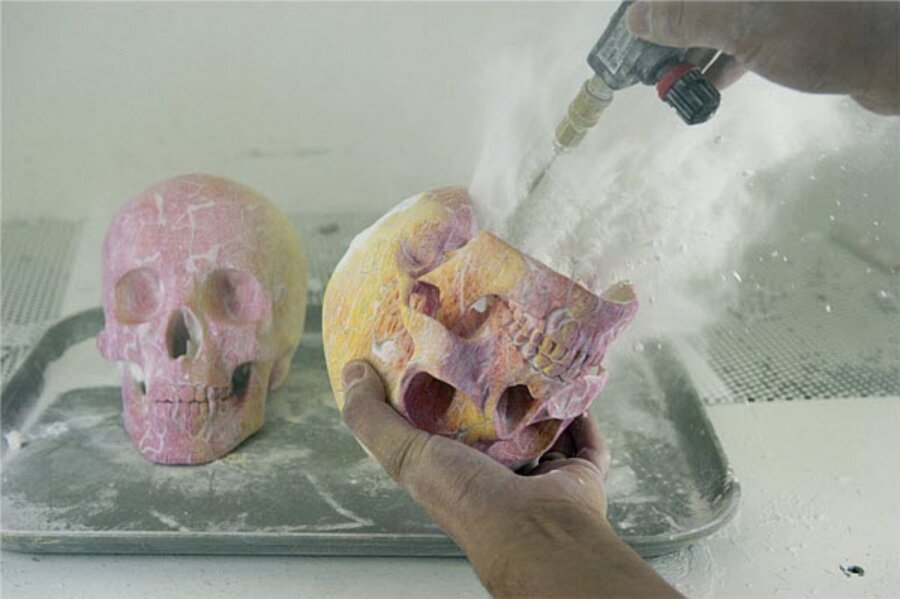Are 3-D printers worth it?
Loading...
If you could make anything you want, what would it be? That's the challenge 3-D printing poses to consumers. But that open-ended question is also a challenge for 3-D printing. Do consumers know what they want, and do they care enough and have the patience to make it?
Home devices such as the MakerBot Replicator and print-to-order companies like Shapeways and Sculpteo can take an idea and make it physical — limited to plastic in the former case but extending to ceramic, plaster, stainless steel and even silver in the latter. Still, you must have the idea to start with.
That's no problem for "makers" — the new hip, high-tech name for hobbyists and home inventors. If you want to design and build a gadget, replace an out-of-stock mechanical part or even create your own jewelry, 3-D printers make it possible and affordable as old technology never could have.
"When you have a MakerBot it makes sense to make anything you want," said Bre Pettis, founder of MakerBot, a company that transformed 3D printers from industrial devices to (somewhat) affordable desktop gadgets. Its flagship MakerBot Replicator 2 sells for $2,199.
And the makers have been busy. MakerBot's Thingiverse site hosts more than 80,000 digital design files that people can download to print anything from toys to tools. They can even tweak the designs in MakerBot's free MakerWare application.
"So that's the beauty of Thingiverse.com," Pettis told TechNewsDaily. "If somebody has an idea and they make it, they can share it, and the whole world benefits." (However, designs for weapons and any illegal items are not allowed.)
The Featured section of Thingiverse, for example, includes customizable iPhone cases, a water bottle with cap, a model of the Winterfell castle from the opening credits to "Game of Thrones" and a "steampunk" version of one of the ghosts from "Pac-Man."
Both fun and useful applications, but not exactly cheap compared to the competition. High-end iPhone cases from companies such as Speck top out around $40. And even a stainless-steel vacuum-sealed thermos bottle sells for just $49.95 from REI. You'd have to make a lot of Thingiverse products to pay off the cost of the 3-D printer and the plastic spools you feed it — to say nothing of the time you invest.
Beyond doodads, a MakerBot can produce "revolutionary" things, as Pettis calls them. His favorite example is the Robohand — a prosthetic for children who were born without fingers. Two makers — one in the U.S. and one in South Africa — collaborated online to create the design. Anyone can download the design and print the components to make the prosthetic.
But very few people need to replace a missing hand — certainly not people in every home. [See video: 3D Printing: From Doodads To Prosthetic Hands]
If you don't plan to churn out plastic creations the way a hobbyist woodworker churns out furniture, a site like Shapeways or Sculpteo may be more for you. They offer their own range of items you can order, as well as take files like those on Thingiverse or your own custom digital designs. Their industrial-scale machines do things that won't happen at home anytime soon, such as creating metal objects.
But printing sites also have plenty of bric-a-brac. On Shapeways they include a 2.6-inch tall statue of a sulking Keanu Reeves for $25 and a $59.99 combination espresso cup-cigarette holder.
There are useful items, too, including a slew of iPhone cases. But beware. The page for the "4-4 Case" for the iPhone 4 carries the disclaimer "…this design is right on the edge of what Shapeways can produce to the right quality..." Problems include fitting poorly and scratching the iPhone. However, it sells for just $12.50.
And even with the great products on Shapeways or other sites, you aren't buying 3-D tech any more than you are buying injection-molding tech for plastic earbuds or glued-together Swedwood tech for Ikea furniture.
In these cases, 3-D printers are business equipment for the companies making the products, which now can include small operations — even one-person outfits — such as those on craft sites like Etsy. That can be good for consumers, but you don't have to even know what 3-D printing is to benefit.
Of course there was a time when computers were expensive, hard to use and mainly gadgets for tinkerers with names like Steve Jobs and Bill Gates. Now many people have an exponentially more powerful doodad that fits in their pocket. That transition took a few decades, however. And even with the pace of technology accelerating, it could be a while before 3-D printers are must-have gadgets — if they ever are.
Follow Sean Captain @seancaptain. Follow us @TechNewsDaily , on Facebook or on Google+.
- 10 Incredible 3-D Printed Products
- 10 Inventions That Were Ahead of Their Time
- 3D Printing: From Trivial to Revolutionary Objects
Copyright 2013 TechNewsDaily, a TechMediaNetwork company. All rights reserved. This material may not be published, broadcast, rewritten or redistributed.







